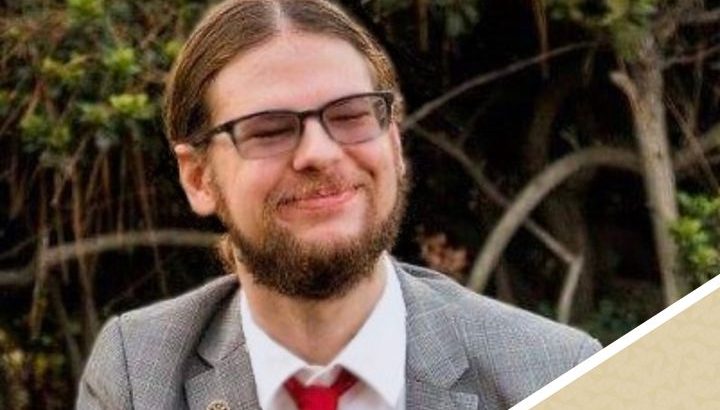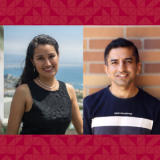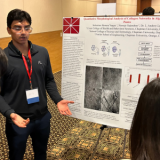
From Biomedical Engineering to Engineering 101: Facilitating Hands-On Experiences for Freshmen and Beyond Faculty Spotlight: Dr. Christopher Girard
September 26, 2023
Faculty Name: Christopher Girard, Ph.D.
Currently Teaching: ENGR 101: Foundations of Design and Fabrication
Research: Simulation of Neuron Interaction, Electrode Implementation, Accelerating the Prototyping of Electrical and Mechanical Systems
With the start of a new academic year, Fowler School of Engineering students look forward to reconnecting with their peers and engaging with classroom content through hands-on experiences. One of the new faculty members who is helping usher in another successful generation of Fowler students is Dr. Christopher Girard. Dr. Girard graduated from the University of Southern California (USC) with his B.S., M.S., and Ph.D. in Biomedical Engineering.
When Dr. Girard came across the opportunity to teach at Chapman, he was thrilled to not only experiment with Fowler’s facilities and equipment but also help educate a new class full of innovative minds. Since then, Dr. Girard has been helping his students navigate the fundamentals of engineering, all while also pursuing his own personal research interests. Dr. Girard was kind enough to share his journey since graduating from USC and starting fresh during fall 2023.
Q&A with Dr. Girard
Q: How have you incorporated industry knowledge and research into teaching engineering fundamentals?
Girard: So, the research aspect hasn’t come into play quite yet. I’m still kind of sorting through what I’ve done, the ongoing work that I did for my dissertation, and how I can bring students into that. More of my background was from when I was a teaching assistant at USC. For four years, I was the assistant for the Capstone Design course. In many ways, it was very similar to what we do in engineering 101, except at USC they didn’t really cover that material until the very end of their four years. So, the kind of more practical hands-on material. Everything up to that there’s plenty of background theoretical knowledge but not as much hands-on application whereas here at Chapman, it’s right off the bat we’re starting with that hands-on. You start with the overall framework of what you do as an engineer and then as you move along and you’re covering the more theoretical topics, you can see better how the individual pieces fit into the big picture.
Q: Are there any similarities or differences you’ve noticed between your own engineering journey during undergraduate and Fowler’s new undergraduate population?
Girard: I am more used to working with seniors [at USC] who, again, had all the theoretical knowledge technically under their belt but never really had a place to hang it. So, I try to strike a balance of not going into excessive detail and boring everyone to death if they already know stuff but I also don’t want to assume they’re already familiar with some topic they’ve never seen before in their lives. So, that’s been a little bit of an adjustment.
Fortunately, because the classes are so small everything is fairly hands-on. I can see right away if I’m making sense or if the students are just completely lost. As an instructor, I love having that ability. For other courses that I TA’d there were in larger lecture settings where you don’t have that same level of feedback.
Q: What are some of your specific research interests? Why did you choose them, and what do you hope to carry with you throughout the school year?
Girard: My formal research was in computational neuroscience. Basically, I wrote some simulation software for modeling how implanted electrodes interact with neurons in the nervous system through the tissue that is in between them. So, lots of good tools for modeling neurons in isolation, even large networks of neurons. But there’s not a very efficient way to handle it if we have this implanted electrode and we’re trying to stimulate this population of neurons in this kind of tissue type. Basically, how does the current get from the neurons of interest and what do we play with parameters like the design of the electrode or the kind of stimulus that we drive the electrode with? How does that affect the neuro-response?
You can kind of get away with very simplified models that have been kind of the standard for a lot of neuroscience research. Or have details modeled of the geometry and very simplified neurons that’s kind of using a software package that’s kind more geared towards industrial simulations. Having an all-in-one suite that can handle both wasn’t really something that’s out there in the world so I tried to write a set of simulation software in Python, that can handle that extra-cellular modeling portion without requiring insane amounts of computational horsepower. Ideally, something that could be run on a moderately robust laptop.
Q: Who or what has been a key influence in helping you stay motivated and continue teaching students at Chapman?
Girard: So, because I am brand-spanking new and I’m still kind of getting myself situated in Chapman, the motivation coming into all of this, and basically the motivation that got me through grad school, was that I’ve always really enjoyed teaching. Especially, the close-interaction-with-students kind of teaching where I can really see “Okay where are they at, what do they want to accomplish, and how can I help them get from where they are to where they want to be”. I’ve had a wide variety of professors that I’ve worked under and studied under and I’ve had a number of fantastic professors and a number of less-than-stellar instructors as well. So, seeing how much of a difference the quality of an instructor can make in how much you get out of the course, that’s kind of my motivation. I want to be able to bring as much value to the individual students as I can and really make the most of their time here at Chapman.
Q: What is your favorite part of teaching at Fowler School of Engineering?
Girard: Less directly connecting to the teaching and more the fact that our Makerspace is phenomenal. When I was at USC we were just starting in the biomedical department to get some sort of Makerspace facility up and running for our undergraduate students. And to be quite honest, the stuff we have here at Chapman is all way nicer stuff and way better organized. I haven’t had a chance to play around too much with the stuff but I’m looking forward to branching out with that and helping the students navigate all the different fabrication technologies that you have. Again there’s something just so satisfying about that and it really helps motivate more theoretical abstract stuff that sometimes you’ll be sitting in a class wondering, “When am I ever going to use this”. When that gets incorporated into the whole engineering workflow you see, “Oh yeah that’s where we’re learning all this stuff. This is what it gets used for.”
So that keeps the motivation levels up.
Visit Dr. Girard’s GitHub to learn more about his research interests and past projects.

